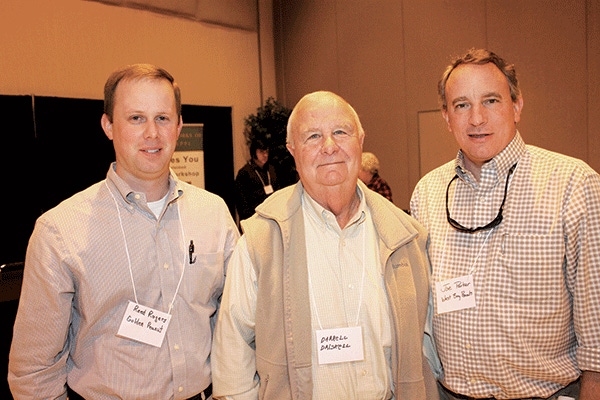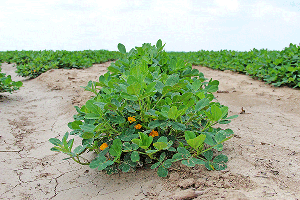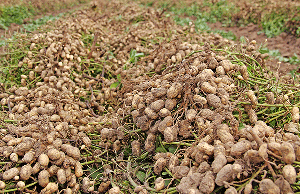
The past few years have been a great time for production agriculture, says Marshall Lamb, research leader at the National Peanut Research Laboratory, Dawson, Ga. "The varieties, systems, and technology growers have to work with are constantly improving. And it’s chiefly due to yield advances from outstanding work in research, and producers putting that research to work on their farms to get better yields.”


MARSHALL LAMB
Major increases in peanut yields in the U.S. are “a really outstanding picture of what growers have been able to achieve by utilizing research that has given them improved varieties and production systems,” says Marshall Lamb.
“In 2012, we set an all-time record of more than 2 tons per acre, which we continued in 2013 and 2014,” he said at the annual meeting of the Mississippi Peanut Growers Association.
And the yield bonanza hasn’t been just in peanuts, he says. “Last year, we reached the highest yield levels ever in corn and soybeans. The past few years have been a great time for production agriculture — the varieties, systems, and technology growers have to work with are constantly improving. And it’s chiefly due to yield advances from outstanding work in research, and producers putting that research to work on their farms to get better yields.”
Lamb, who is research leader at the USDA/ARS National Peanut Research Laboratory at Dawson, Ga., notes that “from the 1920s well into the 1960s, peanut yield was less than 1 ton per acre. A significant shift occurred in the 1970s with the introduction of the Florunner varieties — a major game changer that brought a new, higher yield plateau. Another plateau occurred in the 2000s, and for the 2010-2014 period we’re up to an average yield of roughly 3,700 pounds per acre — a tremendous accomplishment.”

IMPROVED VARIETIES have brought new yield records for peanuts.
In discussing some of the work going on at the National Peanut Research Laboratory, he said, “We have some really good varieties in their infancy, not ready for growers yet, including some high oleic varieties that are showing tremendous promise. We believe in several years we’ll be able to offer growers some varieties that will compete very well and have high oleic chemistry that the industry desires.”
Scientists are also looking at gene markers that regulate drought, he says. “Anything we can do to improve water use efficiency in drought conditions will be of tremendous advantage to growers. We’ve identified two markers that are highly elevated during drought, and this gives us potential to use them in peanut parent lines and, hopefully, to develop varieties with drought tolerance and water use efficiency.
“We’re also having quite a bit of success in increasing folate levels in peanuts — basically turning the peanut into a nutriceutical. Some of our crosses have a three- to four-fold increase in folate levels. It would great to have a peanut with high folate levels that can be beneficial to women in pregnancy, providing a natural source from food rather than through vitamins.”
Work to prevent aflatoxin
Work is also being done to add leaf spot resistance to varieties, Lamb says, and to block development of aflatoxin.
“Aflatoxin is a big issue for the peanut industry, and anything we can do to prevent its development is very important. In lab studies, Dr. Rene Arias has significantly reduced aflatoxin B1 and B2 by silencing a signal that produces the toxin.

SILENCING a gene could lead to stopping aflatoxin development in peanuts.
“During drought, A. flavus becomes more competitive in the soil and can move into peanut pods. The plant’s response is to fight back, but A. flavus can generally overpower it. With RNA interference, Dr. Arias has found a way to silence the A. flavus gene that causes it to secrete its toxin. It’s science that’s never been done before on peanuts, and we’re very excited about it.”
There may also be opportunities for farmers to look at alternative storage systems, Lamb says, such as hermetically sealed bags with controlled atmosphere. “ This year, we’ll be studying storing peanuts in these bags after they’re dried. The bags are very cost-effective for grains, and with expanded peanut acreage, we believe growers could use them to extend their marketing period while still maintaining peanut quality. Oxygen levels decline very fast in these bags, which keeps down growth of any pests or fungi. It’s an area that’s showing promise.
“We’re looking at breathability of tote bags used in international shipments, and drip irrigation — both deep and shallow — at sites in Mississippi, Alabama, and Georgia.”
Research is continuing on the use of chemical applications to terminate flowering of peanut plants late in the season, Lamb says.
“At a certain point in the growing season, any new flowers that turn into pegs are never going to have time to become mature enough to harvest. So, why waste plant energy and nutrients to produce these immature pegs?
“We’re using a BASF product, diflufenzopyr, to stop flowering and allow the full season peanuts to mature more quickly. We want to see how this affects yield, flavor, and oleic content. We’ve had plots in south Mississippi and in the north Delta, as well as other sites in the southern states.”
At all locations over three years, Lamb says, yield on untreated plots was 5,400 lbs., while plots treated with low rates of the BASF product yielded 5,800 lbs. to 5,900 lbs., “a significant increase.”
High oleic varieties promising
High oleic peanuts continue to show promise, he says."Florida research has shown these varieties can delay development of rancidity and off flavors. Non-high oleic peanuts start degrading after about four weeks from oxygen exposure, while high oleic peanuts can go up to 32 weeks, offering stable flavor longer, which offers a major advantage to manufacturers in avoiding bad experiences with consumers with off-flavor products.”

HIGH OLEIC peanuts give manufacturers a long shelf life for avoiding rancidity and off flavors.
Stay current on what’s happening in Mid-South agriculture: Subscribe to Delta Farm Press Daily
With Mississippi State University’s increased focus on peanut production, and the hiring last year of an Extension peanut specialist, Jason Sarver, and other great scientists “You now have a world class team of specialists to help you with research, information, and advice,” Lamb says.
“The work they’re doing can help you to continue to achieve higher levels of production and efficiency.
It has been impressive, over the last 10 years, to see how Mississippi State University and Mississippi peanut producers have helped to advance our industry.”
About the Author(s)
You May Also Like



